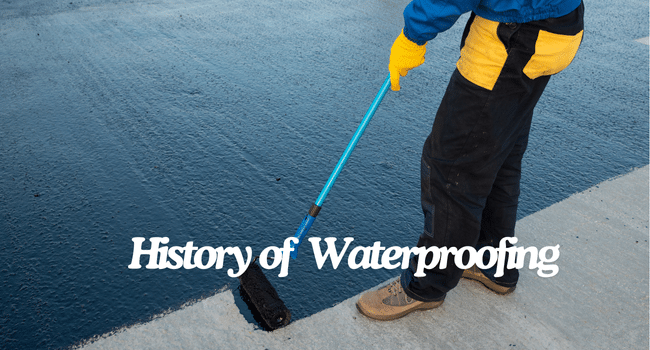Waterproofing has remained a vital practice since the oldest human civilizations throughout history, as humans have sought to figure out techniques to protect their homes, farms, or temples from the ill effects of water-related problems such as erosion, mold, and structural damage. The practice of waterproofing is an essential part of the initial and middle stages of construction.
During the ancient times of Mesopotamians or Egyptians, construction workers were commanded to use natural materials like Bitumen, a potent agent for many waterproofing-type materials. These techniques effectively protected buildings from harsh weather, such as rain and humidity during wars, and also adapted to India’s complex and unpredictable climate. Fortunately, we Indians also have a deep history of advancement in waterproofing techniques used by our ancestors.
In the ancient era, Egyptians employed natural earthly materials such as Bitumen and limericks for waterproofing applications. Bitumen is a sub-product of petroleum mainly used to waterproof roofs or exteriors of a site. Societies began to develop, as did Romans when they took waterproofing techniques to another level by adding lime-based mortars, volcanic ash, and Bitumen for their kingdoms or palaces.
After combining all the materials, it acted as an instrument to build bridges, dams, and baths that could withstand tons and tons of force of water. Surprisingly, these ancient waterproofing techniques have been modernized and applied in major urban cities like Hyderabad. Waterproofing services in Hyderabad use these cutting-edge materials for their waterproofing applications.
Waterproofing is essential to building in Kerala, an area renowned for its heavy precipitation and tropical weather. Because of their proximity to bodies of water, buildings in places like Ernakulam have particular moisture control difficulties. To protect houses and businesses from the detrimental effects of water, Ernakulam has developed waterproofing to match the area’s unique needs. This includes the use of eco-friendly coatings and sophisticated liquid-applied membranes.
Global waterproofing techniques kept developing over time. In Asia, natural materials like palm leaves were utilized for rural waterproofing, while tar and pitch, a type of joint sealer, was employed to shield homes from rain in Europe. However, the actual revolution in waterproofing was brought about by contemporary technology, which changed the industry by introducing cutting-edge materials like bituminous membranes, polyurethane coatings, and PVC membranes. These cutting-edge solutions, which demonstrate the strength of contemporary technology, offer enduring defense against water damage, guaranteeing that today’s residential and commercial structures stay dry and structurally sound.
Throughout the ages, waterproofing has evolved from straightforward, all-natural methods to more specialized systems intended to fend off water intrusion. The value of waterproofing, however, has remained constant. It is still as important today as it was back then, whether you’re protecting a new skyscraper or a historical relic.
The need for sophisticated waterproofing solutions is still driven by India’s expanding construction industry, especially in coastal and metropolitan areas. The varying seasons in Telangana and the intense heat and humidity of Kerala necessitate different techniques for waterproofing. For instance, as high-rise structures proliferate in Hyderabad, there is a growing need for waterproofing services as developers look to shield their roofs and foundations from potential water damage. Additionally, extensive waterproofing in Ernakulam is necessary for modern flats and traditional residences constructed in the Kerala style to survive the region’s anticipated high humidity levels and severe rains.
The development of waterproofing from the era of bitumen-coated boats to modern high-tech membranes demonstrates how creatively humans have responded to the demands of the natural world. The importance of waterproofing in maintaining the durability and security of structures is growing as cities like Hyderabad and Ernakulam expand. Waterproofing solutions have been developed to satisfy the needs of both historic and contemporary structures by fusing ancient wisdom with current technology, guaranteeing that residences and commercial buildings can survive the forces of water for many years to come.
